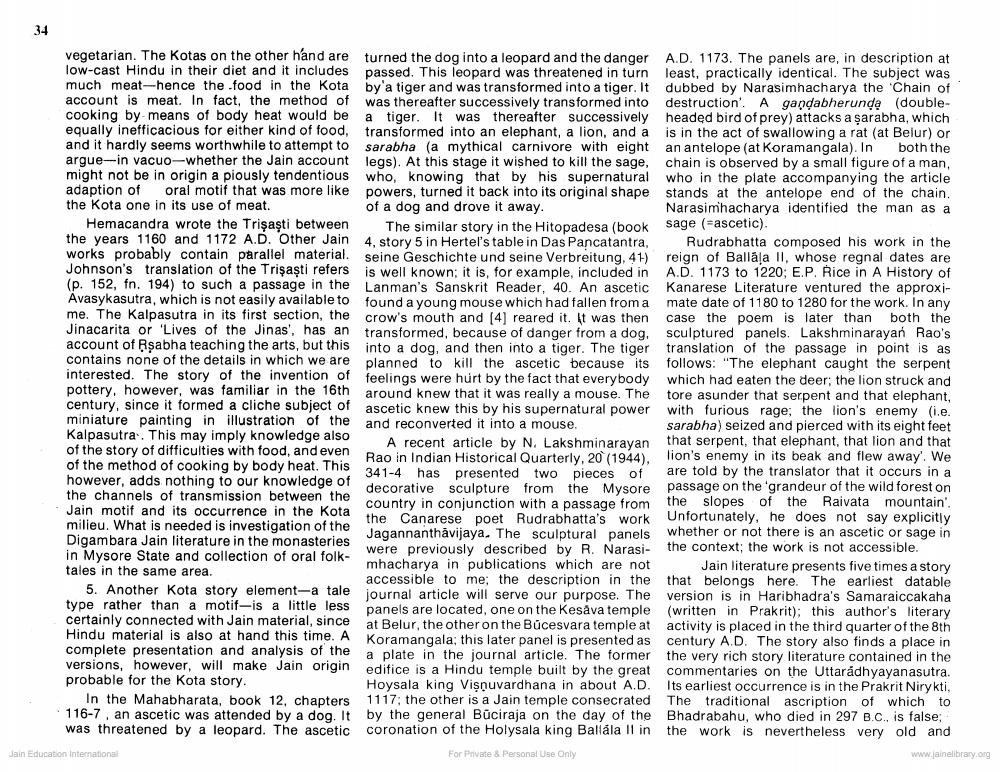________________
vegetarian. The Kotas on the other hand are turned the dog into a leopard and the danger A.D. 1173. The panels are, in description at low-cast Hindu in their diet and it includes passed. This leopard was threatened in turn least, practically identical. The subject was much meat-hence the food in the Kota by'a tiger and was transformed into a tiger. It dubbed by Narasimhacharya the Chain of account is meat. In fact, the method of was thereafter successively transformed into destruction'. A gandabherunda (doublecooking by means of body heat would be a tiger. It was thereafter successively headed bird of prey) attacks a şarabha, which equally inefficacious for either kind of food, transformed into an elephant, a lion, and a is in the act of swallowing a rat (at Belur) or and it hardly seems worthwhile to attempt to
nivore with eight an antelope (at Koramangala). In both the argue-in vacuo-whether the Jain account legs). At this stage it wished to kill the sage, chain is observed by a small figure of a man, might not be in origin a piously tendentious who, knowing that by his supernatural who in the plate accompanying the article adaption of oral motif that was more like powers, turned it back into its original shape stands at the antelope end of the chain. the Kota one in its use of meat. of a dog and drove it away.
Narasimhacharya identified the man as a Hemacandra wrote the Trişasti between the similar story in the Hitopadesa (book Sage ( ascetic). the years 1160 and 1172 A.D. Other Jain 4, story 5 in Hertel's table in Das Pancatantra, Rudrabhatta composed his work in the works probably contain parallel material. seine Geschichte und seine Verbreitung, 41) reign of Ballala II, whose regnal dates are Johnson's translation of the Trişasti refers is well known; it is, for example, included in A.D. 1173 to 1220; E.P. Rice in A History of (p. 152, fn. 194) to such a passage in the Lanman's Sanskrit Reader, 40. An ascetic Kanarese Literature ventured the approxiAvasykasutra, which is not easily available to found a young mouse which had fallen from a mate date of 1180 to 1280 for the work. In any me. The Kalpasutra in its first section, the crow's mouth and [4] reared it. It was then case the poem is later than both the Jinacarita or 'Lives of the Jinas', has an transformed, because of danger from a dog. Sculptured panels. Lakshminarayan Rao's account of Rşabha teaching the arts, but this into a dog, and then into a tiger. The tiger translation of the passage in point is as contains none of the details in which we are planned to kill the ascetic because its follows: "The elephant caught the serpent interested. The story of the invention of feelings were hurt by the fact that everybody which had eaten the deer; the lion struck and pottery, however, was familiar in the 16th around knew that it was really a mouse. The tore asunder that serpent and that elephant, century, since it formed a cliche subject of ascetic knew this by his supernatural power with furious rage; the lion's enemy (ie. miniature painting in illustration of the and reconverted it into a mouse.
sarabha) seized and pierced with its eight feet Kalpasutra. This may imply knowledge also
A recent article by N. Lakshminarayan that serpent, that elephant, that lion and that of the story of difficulties with food, and even
Rao in Indian Historical Quarterly, 20 (1944), lion's enemy in its beak and flew away'. We of the method of cooking by body heat. This
341-4 has presented two pieces of are told by the translator that it occurs in a however, adds nothing to our knowledge of
decorative sculpture from the Mysore passage on the grandeur of the wild forest on the channels of transmission between the
country in conjunction with a passage from the Jain motif and its occurrence in the Kota
slopes of the Raivata mountain'. the Canarese poet Rudrabhatta's work Unfortunately, he does not say explicitly milieu. What is needed is investigation of the
Jagannanthāvijaya. The sculptural panels whether or not there is an ascetic or sage in Digambara Jain literature in the monasteries
were previously described by R. Narasi- the context; the work is not accessible. in Mysore State and collection of oral folk
mhacharya in publications which are not Jain literature presents five times a story tales in the same area.
accessible to me, the description in the that belongs here. The earliest datable 5. Another Kota story element-a tale journal article will serve our purpose. The version is in Haribhadra's Samaraiccakana type rather than a motif-is a little less panels are located, one on the Kesäva temple (written in Prakrit); this author's literary certainly connected with Jain material, since at Belur, the other on the Bucesvara temple at activity is placed in the third quarter of the 8th Hindu material is also at hand this time. A Koramangala, this later panel is presented as century A.D. The story also finds a place in complete presentation and analysis of the a plate in the journal article. The former the very rich story literature contained in the versions, however, will make Jain origin editice is a Hindu temple built by the great commentaries on the Uttaradhyayanasutra. probable for the Kota story.
Hoysala king Vişnuvardhana in about A.D. Its earliest occurrence is in the Prakrit Nirykti, In the Mahabharata, book 12, chapters 1117, the other is a Jain temple consecrated The traditional ascription of which to 116-7, an ascetic was attended by a dog. It by the general Büciraja on the day of the Bhadrabahu, who died in 297 B.C., is false; was threatened by a leopard. The ascetic coronation of the Holysala king Ballála Il in the work is nevertheless very old and
Jain Education International
For Private & Personal Use Only
www.jainelibrary.org




